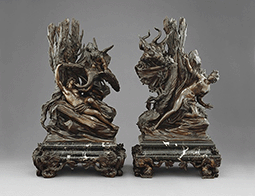Volume 7, Issue 1 (2020) Proceedings from the 2020 Annual Meeting of the Document Academy
PDOCAM'20 Introduction
Grant Campbell
Towards the end of Werner Herzog’s documentary, The Cave of Forgotten Dreams, Herzog indulges in a piece of what he calls “ecstatic truth”: a celebration of albino crocodiles whose beauty he imagines results from exposure to radiation from a nearby nuclear plant. Herzog’s fanciful conceit turns these beautiful and frightening creatures into evidence of human folly. The crocodiles, he suggests, are monsters: monsters created by human beings. In Herzog’s treatment, they become evidence. They become, in a strange sense, documents.
When Tim Gorichanaz, Jodi Kearns, Kiersten Latham, and I set out to plan the 2020 DOCAM Symposium in the Fall of 2019, we hunted for a theme that would activate discussion of documents, not just in the sessions, but also over coffee and dinner. Eventually, we hit upon a daft idea. Suppose we make “monsters” the theme of our symposium?
After some initial flinching, we started to fall into the idea. After all, we’re a community that studies documents, and documents have historically opened doors to places in the imagination: not just in the stories they tell, but in the stories they embody, the rituals they enact, the fear they inspire, and the contradictions they evoke between a desire to tell and a desire to suppress, a desire to reach out and a desire to curl back. Documents, and documentary practices, are haunted by the strange, the macabre, the grotesque, the fantastical. Monsters lurk on the edges of maps; they lie in book curses; they pop up in our everyday taxonomies, our memos, our photocopiers; they hide in our museums, in our collections of old letters, our airline advertisements.
Sometimes they’re scary; sometimes they’re ludicrous; sometimes they’re poignant; sometimes, like Herzog’s crocodiles, they’re beautiful, even as they terrify us.
But monsters and documents touch each other at multiple points.
In 1890, a mere five years before Otlet and La Fontaine began to encode human knowledge in their Repertoire Bibliographique Universel, Oscar Wilde published The Picture of Dorian Gray, his famous story about a man whose youth and beauty are encoded into a portrait of himself. As Dorian Gray leads an increasingly vicious and debauched life, his beauty never changes; but the document that serves as his surrogate—the portrait—becomes increasingly hideous. And Dorian’s unchanging beauty becomes hideous, as well.
For centuries, monsters have dominated our imaginative lives: figures of terror that exist at the intersection of fixity and change. Sometimes, the monstrous appears as a transformation, in which something or someone familiar “turns” into something else: perhaps a serpent, a vampire, or a ghost. At other times, the monstrous manifests itself, as in the case of Dorian Gray, as a false state of fixity.
Documents also exist at this intersection of fixity and change, and evoke similarly complex cultural responses: the problematic triumph of typographical fixity over scribal drift, and the equally problematic emergence of digital metamorphosis against the backdrop of print culture. This year, the Document Academy sought work from across the world that explored the monstrous in documents and documentary analysis, seeking to address two broad questions:
a. What is the relationship between fixity and transformation in document creation and use?
Documents sometimes preserve fixity through the technologies of production, such as printing presses and photocopiers. Sometimes, documents can change through context: an innocuous memo can suddenly become terrifying, and a digital trace can create strange transformations.
b. Where are the monsters? Inside us? Or beyond us?
Documents can bear witness to the dazzling strangeness of the world beyond our doors: they can also bear witness to the strangeness that lies within ourselves.
When we started planning our conference in 2019, we anticipated gathering in person at the University of Western Ontario in August of 2020. But the year has brought transformations in all of our lives, and we found ourselves communicating remotely instead. Even as the pandemic forced us into ever-smaller bubbles, scholars from across the world joined together to discuss and to celebrate documents, and the study of documents. The discussions were diverse; the approaches varied; the contexts surprising. Documents led us into scary places in human history, and even scarier places in current human procedures. Documents also led us into places of surprising optimism and unexpected perplexity. Like the crocodiles whom Herzog imagined changing colour in response to human activity, the documents we examined proved to be beautiful and frightening.
Conference Proceedings
Documentary Ghosts
Tim Gorichanaz
Two-headed Calves, Unicorn Horns, and Trephined Skulls: An Essay about Beautiful Museum Monsters
Kiersten F. Latham
The Brazilian Neodocumentalist Movement: an Historical Perspective
Gabriela Fernanda Ribeiro Rodrigues
Seeing Indonesian Ghost Films through Document Theory
— Suprayitno, Dian Novita Fitriani, Rusdan Kamil, and — Rahmi
Books and Imaginary Being(s): The Monstrosity of Library Classifications
Melissa Adler and Greg Nightingale
Three Monstrosities of Information
Ronald E. Day
“What Is Truly Scandinavian?”—A SAS Commercial and the Document Complex Surrounding It
Roswitha Skare
Navigating Monsters: Credibility in the Twittersphere
Carrie A. Boettcher
Embracing Monsters
Laurie J. Bonnici and Brian C. O'Connor
The Vampire that Refused to Die: Dracula and Nosferatu
Louis J. D'Alton
Rhizome Blues: Introducing Document Teratology
Arthur Perret, Olivier Le Deuff, and Clément Borel
The Ontological Status of Sound Recording: An Artistic Blend between Documentation and Sonic Aesthetics
Gaute Barlindhaug
Documental Fixity
Asy Sanches and Ronald E. Day
Issue Editors
- Guest Editor, DOCAM'20 Chair
- Grant Campbell
- Editor
- Tim Gorichanaz
- Editor
- Jodi Kearns
- Editor
- Kiersten F. Latham
Online Symposium
held August 6, 2020
May we all meet again in health and safety—and in person—in 2021. Until then, let us continue to combine social distance with intellectual interchange, reminding ourselves in both cases what it means to be a community. - 2020 DOCAM Chair, Grant Campbell
